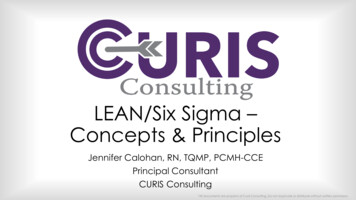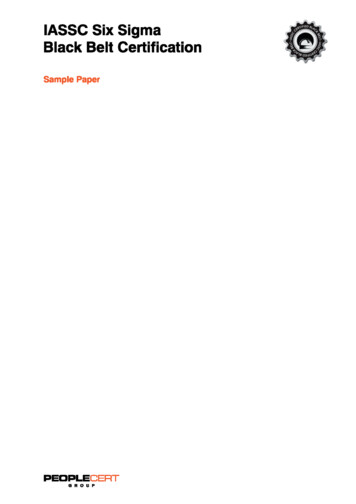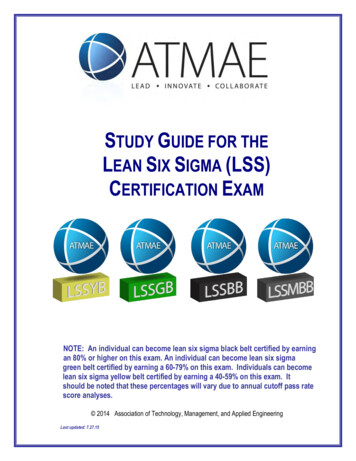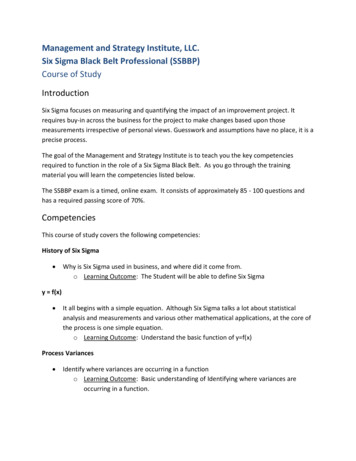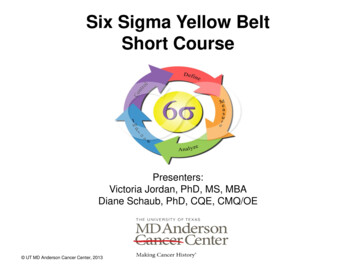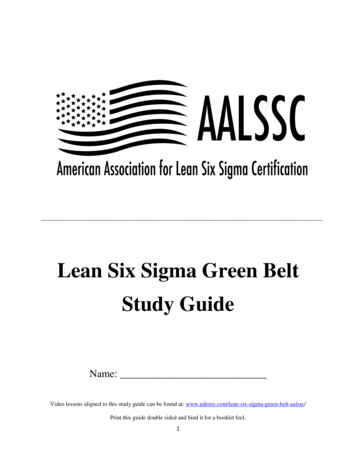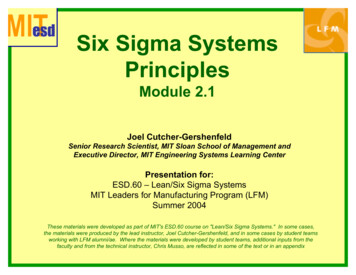
Transcription
Six Sigma SystemsPrinciplesModule 2.1Joel Cutcher-GershenfeldSenior Research Scientist, MIT Sloan School of Management andExecutive Director, MIT Engineering Systems Learning CenterPresentation for:ESD.60 – Lean/Six Sigma SystemsMIT Leaders for Manufacturing Program (LFM)Summer 2004These materials were developed as part of MIT's ESD.60 course on "Lean/Six Sigma Systems." In some cases,the materials were produced by the lead instructor, Joel Cutcher-Gershenfeld, and in some cases by student teamsworking with LFM alumni/ae. Where the materials were developed by student teams, additional inputs from thefaculty and from the technical instructor, Chris Musso, are reflected in some of the text or in an appendix
Overview¾ Learning Objectives¾ Review core Six Sigma concepts¾ Explore the relationship between“lean” and “six sigma”¾ Session Design (20-30min.)¾ Part I: Introduction and LearningObjectives (1-2 min.)¾ Part II: Key Concept or PrincipleDefined and Explained (5-7 min.)¾ Part III: Exercises and ActivitiesBased on Field Data andScenarios that Illustrate theConcepts or Principles (5-7 min.)¾ Part IV: Common “Disconnects,”Relevant Measures of Success,and Potential ActionAssignment(s) to Apply LessonsLearned (3-5 min.)¾ Part V: Evaluation andConcluding Comments (2-3 min.) Joel Cutcher-Gershenfeld – ESD.60 Lean/Six Sigma Systems, LFM, MITPart I: IntroductionPart II: ConceptsPart III: Application6/9/04 -- 2Part IV: DisconnectsPart V: Conclusion
Six Sigma¾ Concept:¾ The Goal: To produce goods and services at a Six Sigma level. Asyour organization moves toward Six Sigma quality, you will:¾ eliminate defects¾ reduce production and development costs¾ reduce cycle times and inventory levels¾ increase profit margin and improve customer satisfaction¾ The Vision: Drive industries to design and produce products/servicesto Six Sigma standards.¾ The Strategy: Use a data-driven structured approach to attack defectsto improve the sigma level of your goods and services.¾ Application:¾ Useful in any enterprise that provides products or services forcompanies Joel Cutcher-Gershenfeld – ESD.60 Lean/Six Sigma Systems, LFM, MITPart I: IntroductionPart II: ConceptsPart III: Application6/9/04 -- 3Part IV: DisconnectsPart V: Conclusion
Core Concept: Stabilize Before You ImproveWhich player did better in this round?Who will do better in the long run? Joel Cutcher-Gershenfeld – ESD.60 Lean/Six Sigma Systems, LFM, MITPart I: IntroductionPart II: ConceptsPart III: Application6/9/04 -- 4Part IV: DisconnectsPart V: Conclusion
Core Concept: y f(x)¾ How do you determine “y”?¾ How do you determine the “x”s?¾ How do you collect the data on the “x”s?¾ How do you conduct the f(x) analysis? Joel Cutcher-Gershenfeld – ESD.60 Lean/Six Sigma Systems, LFM, MITPart I: IntroductionPart II: ConceptsPart III: Application6/9/04 -- 5Part IV: DisconnectsPart V: Conclusion
Six Sigma¾ Master Blackbelt¾ Complete Blackbelt Certification¾ 18 Mo. Additional training to broaden skill set, ProfessionalDevelopment, acquire expertise in ability to train others¾ Complete a Project with Significant Importance to the Success ofthe Company¾ Blackbelts¾ 240 Hours Focusing on Business, Engineering, ManufacturingProcesses Improvement¾ Project Worked in Parallel to Reinforce Training¾ Greenbelts¾ 80 Hours Focusing on Assisting Blackbelts, Running Small ScaleProjects¾ Project Worked in Parallel to Reinforce Training¾ Leadership (300 ) - 8 Hours of Six Sigma Awareness andProject SupportSource: Six Sigma Materials from Qualtec and Aerojet Corp. as utilized in: MIT’s LAI LeanImplementation Fieldbook, developed by Michael Chapman, Joel Cutcher-Gershenfeld, GregoryManuel, Gina Mile, Jeanine Miller, Mike Packer, Robert Reifenberg, and David Veech. Joel Cutcher-Gershenfeld – ESD.60 Lean/Six Sigma Systems, LFM, MIT6/9/04 -- 8Source Six Sigma QualtecPart I: IntroductionPart II: ConceptsPart III: Application Part IV: Disconnects Part V: Conclusion
Six trolControlProblem Solving GaugeDesign sEffectsAnalysisAnalysisFailureMistake-Proofing/ /ControlControlPlansPlansMistake-Proofing4 Phases of Improvement Using 9 Key ToolsSource Six Sigma QualtecSource: Six Sigma Materials from Qualtec and Aerojet Corp. as utilized in: MIT’s LAI LeanImplementation Fieldbook, developed by Michael Chapman, Joel Cutcher-Gershenfeld, GregoryManuel, Gina Mile, Jeanine Miller, Mike Packer, Robert Reifenberg, and David Veech. Joel Cutcher-Gershenfeld – ESD.60 Lean/Six Sigma Systems, LFM, MITPart I: IntroductionPart II: ConceptsPart III: Application6/9/04 -- 9Part IV: DisconnectsPart V: Conclusion
Six Sigma at GEKey Concepts of Six SigmaCritical to Quality:Attributes most important to the customerDefect:Failing to deliver what the customer wantsProcess Capability:What your process can deliverVariation:What the customer sees and feelsStable Operations:Ensuring consistent, predictable processes toimprove what the customer sees and feelsDesign for Six Sigma:Designing to meet customer needs andprocess capabilityOur Customers Feel the Variance, Not the MeanSource: http://www.ge.com/sixsigma/sixsigstrategy.html Joel Cutcher-Gershenfeld – ESD.60 Lean/Six Sigma Systems, LFM, MITPart I: IntroductionPart II: ConceptsPart III: Application6/9/04 -- 10Part IV: DisconnectsPart V: Conclusion
Six Sigma and Lean¾ Based on the information in the prior slide on Six Sigmaat GE, what can you infer about the relationship between“lean” and “six sigma”?¾ What do you see as the potential risks and benefits of“lean” and “six sigma”? Joel Cutcher-Gershenfeld – ESD.60 Lean/Six Sigma Systems, LFM, MITPart I: IntroductionPart II: ConceptsPart III: Application6/9/04 -- 11Part IV: DisconnectsPart V: Conclusion
Project Worked in Parallel to Reinforce Training Leadership (300 ) - 8 Hours of Six Sigma Awareness and Source Six Sigma Qualtec Six Sigma Materials from Qualtec and Aerojet Corp. as utilized in: Implementation Fieldbook, developed by Michael Chapman, Joel Cutcher-Gershenfeld, Gregory Manuel, Gina Mile, Jeanine Miller, Mike Packer, Robert Reifenberg, and David Veech. Part I: Introduction Part .


